Schools
What do these photos tell you about how the schools miners' children attended were like?
One Room School Near Telluride
The building in this photo is a one-room school near the town of Telluride, Colorado. Six girls, two men, and a boy on a burro are standing in front of the building.
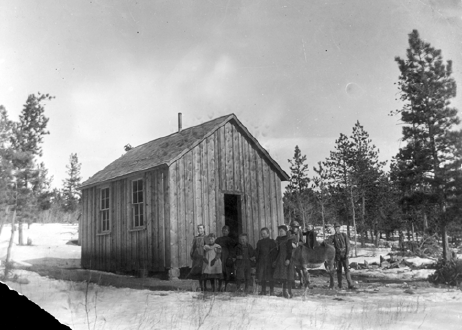
Photo: Denver Public Library, Western History Collection
More About This Topic
The families who settled in mining communities wanted their children to have a good education. They built a schoolhouse as soon as they could. Small communities built one-room schools like the one in this photo.
Their Own Words
"We rode horseback to school, sometimes as many as three of the smaller children riding on one horse. Our saddles were hung on the side of the schoolhouse and our horses tied to nearby bushes. I was amazed when I saw the schoolhouse. . .It was made of logs and had been built in a day by the men in the settlement. The dimensions were about fourteen by sixteen feet. The logs were chinked and daubed with adobe mud. In many places the mud had fallen out. If a child wanted to look at anyone passing, he would peak between the logs."
Source: Nellie Carnahan Robinson, "The Recollections of a Schoolteacher in the Disappointment Creek Valley," Colorado Magazine, 51 (Spring 1974).
Catholic School In Georgetown
This school was located in the mining town of Georgetown. It was a Catholic school. The building was made of brick.
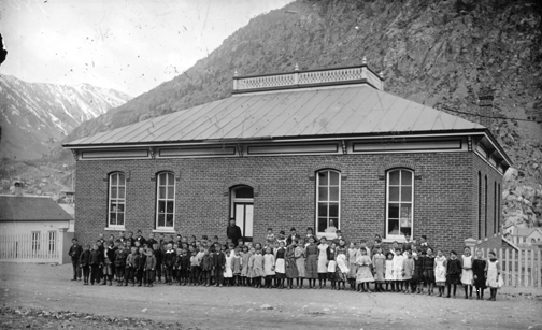
Photo: Denver Public Library, Western History Collection
More About This Topic
Larger mining towns such as Georgetown built schools with more than one room. This Catholic school in Georgetown had at least four rooms. Georgetown also had a public school.
Their Own Words
“For three years we children, along with the boys of the Mexican population, were sent to a parochial school conducted by the Sisters of Charity. They were good women, but the only ones of them that remain in my memory to this day were the devout Mother Superior, who was the salt of the earth, and a young sister named Beatrice with a peaches and cream complexion, with whom we small boys were all in love.”
Source: James K. Hastings, “Boyhood in the Trinidad Region,” Colorado Magazine, 30 (April 1953): 105.
Brick School In Central City
This stone school building was located in the mining town of Central City, Colorado. The school was built in 1874.
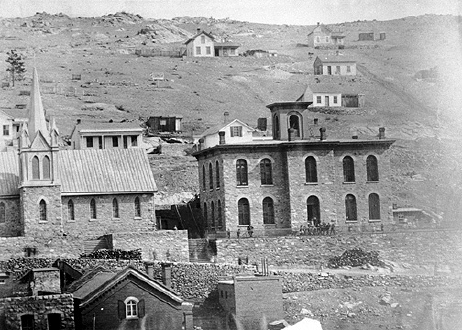
Photo: Denver Public Library, Western History Collection
More About This Topic
The town of Central City served a large and prosperous mining community. In 1874, it built one of the finest schoolhouses in Colorado. It also was one of the largest buildings in town. This fine building showed how much the people of Central City valued education.
Their Own Words
"The period between 1870 and 1882, when I lived there [Central City]. . . . We all attended the stone schoolhouse on the hill. Some [of the boys] were good and others not so good. . . . We were all supposed to be studying. [Charles] Collier included, which was so unusual that The Little Squire, as we always called our principal, H. M. Yale, tiptoed to the rear of the room and came quietly behind Collier. Lo and behold, he was reading a Beadle dime novel concealed in his Geography! Mr. Hale grabbed him by the nape of the neck and seat of the trousers, carried him to his desk, and gave him a good paddling, much to the amusement of the class."
Source: “Boyhood Recollections of Central City in 1870s,” Central City Weekly Register-Call, August 11, 1939.
Schoolhouse In Silver Plume
This is the first schoolhouse in the mining town of Silver Plume, Colorado. The photo was taken in 1884 or 1885. The children are holding books.
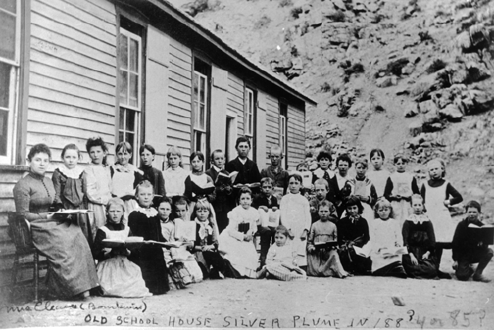
Photo: Colorado Historical Society
More About This Topic
Silver Plume was Georgetown’s smaller neighbor. It did not need a big, brick schoolhouse. Like other small towns in the mining regions, Silver Plume had a small, one-room school.
Their Own Words
[People who wanted to be teachers in Colorado in the 1870s had to pass this test.]
"Find the side of a cubical tank to hold 4,725 gallons of water. Find the least number which divided 3, 7, 11, and 21 leaves a remainder of 2 each time. Define syncope, epocope, ellipsis, and hyperbole. Make a proper use of capitals, arrange into verse, and punctuate the following: 'she continued moreover it is written that my race hewed ammon hip and thigh from arorer on amon unto minnith here her face lowed as I looked at her'--tennyson. What are the departments of the U.S. government and their respective powers? Name the Cabinet officers. How many members of Congress has each state? Give the dates of the landing of the pilgrims, discovery of America, adoption of the Constitution, commencement of the Mexican War, and commencement of the late Rebellion. Define equator, earth's axis, parallels, meridians. Name in order of the location of the States that border on the Atlantic, Gulf of Mexico, and the Pacific."
Source: Colorado Territorial Superintendent of Schools, First Biennial Reports.
Leadville School Teachers
This photo was taken at the Ninth Street School in Leadville, Colorado. The principal and seven women teachers are sitting on the steps in front of the school.
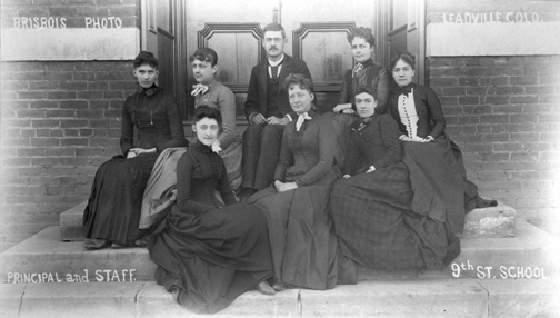
Photo: Denver Public Library, Western History Collection
More About This Topic
In the 1880s, Leadville was the largest mining town in Colorado. It also needed large schools. The number of teachers in this photo indicates that the Ninth Street School had at least seven rooms.
Their Own Words
“My childhood and girlhood were tied very closely with the Healy House. Miss Nelly Healy and my sister Saidee E. Edwards were dear friends. Both were teachers at the Ninth Street School. Another Leadville teacher I admired very much was Miss McMechen. . . . I considered her the prettiest teacher there. I can picture her now, an ideal for a little girl. Miss Healy, who later was my teacher in the B-6th grade, used to take me to see her young cousins . . . who lived in the house which is now called ‘Healy House.’”
Source: Mattie Edwards Stuthman, “High Altitude Memories,” Colorado Magazine, 24 (January 1952): 36.

